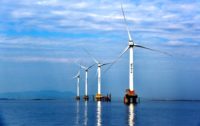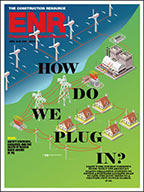Three, 9-meter-dia wind turbines are due to be installed this month atop London’s new, 148-m-tall Strata SE1 building in the Elephant & Castle district. As well as providing visual interest for the city’s tallest residential building, the turbines are forecast to provide 8% of the electricity consumed by its 408 apartments.
The Strata project is the “first time any building in the world has integrated wind turbines into the envelope … of the building,” says Justin Black, development director of the project’s main contractor and owner, Brookfield Europe Ltd., London.
Topped out late last month in China, the 310-m-tall Pearl River Tower, a commercial building with curtain-wall-integrated turbines, is close on Strata’s heals. The China building is set for completion later this year.
With residents due to start moving in this June, the 43-story Strata is the first of several high-rises planned for Elephant & Castle, which is located a few kilometers south of the River Thames. Around 70 hectares of the 1960s-era mixed-use development, in need of a face-lift, is scheduled for a $2.2-billion redevelopment.
When Brookfield took up the $170-million Strata project some five years ago, London Mayor Ken Livingston was starting to promote greener high-rises and on-site power generation, says Black.
Brookfield investigated but ruled out solar power generation, then a relatively embryonic technology, says Black. “Wind-turbine technology hasn’t advanced over the past five years as has photovoltaic … which might now be more efficient,” he adds.
Also, “The idea of integrating the wind turbines was to change people’s perception of what a building should be … that the building is doing something,” says Damien Kenny, the project’s lead mechanical and electrical designer at WSP Cantor Seinuk, London. WSP is also Strata’s structural designer.
Each wind turbine is housed in a horizontal steel cylinder, called a Venturi. By exploiting the air-pressure differential between the front and back of the building, the Venturis accelerate air through the turbines. That arrangement allows them to generate the same power as similar but freestanding turbines with winds at about 12 m per sec, according to Brookfield.
The company let a roughly $2-million turnkey contract for the wind power system to a Danish team of design firm Rambøll Denmark A/S, Copenhagen, and turbine supplier Norwin A/S, Gadstrup. The same team was responsible for the larger, 29-m-dia externally mounted turbines, installed three years ago at Bahrain’s World Trade Centre.
Each of Strata’s turbines will be mounted on a prop rising from a steel-and-concrete frame weighing about 5 tonnes. Measuring roughly 5-m square in plan, the frames each sit on four industrial vibration dampers, one under...







